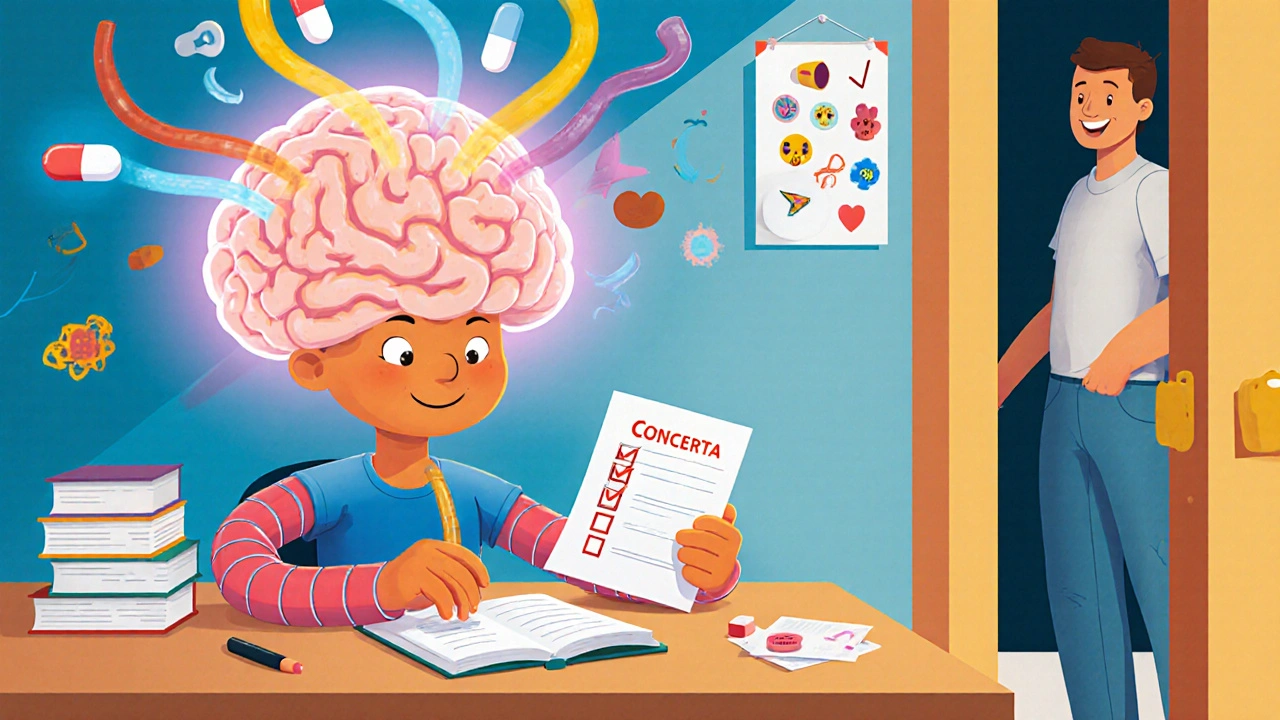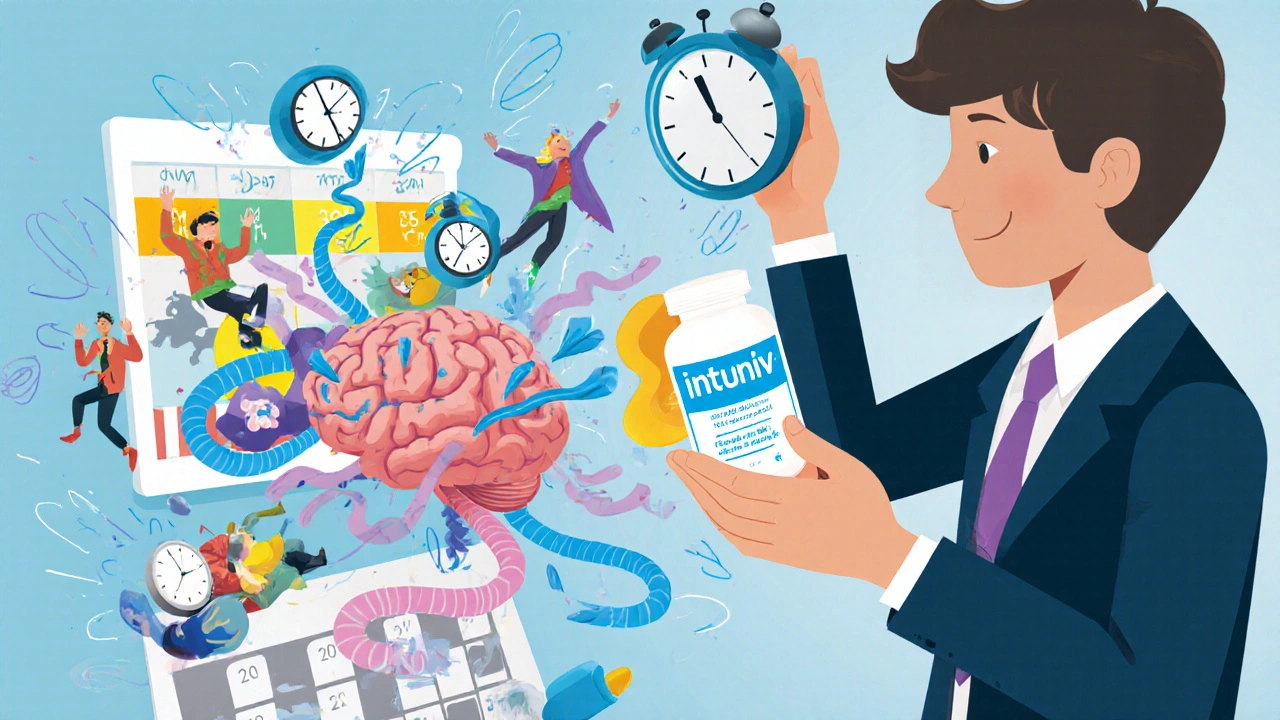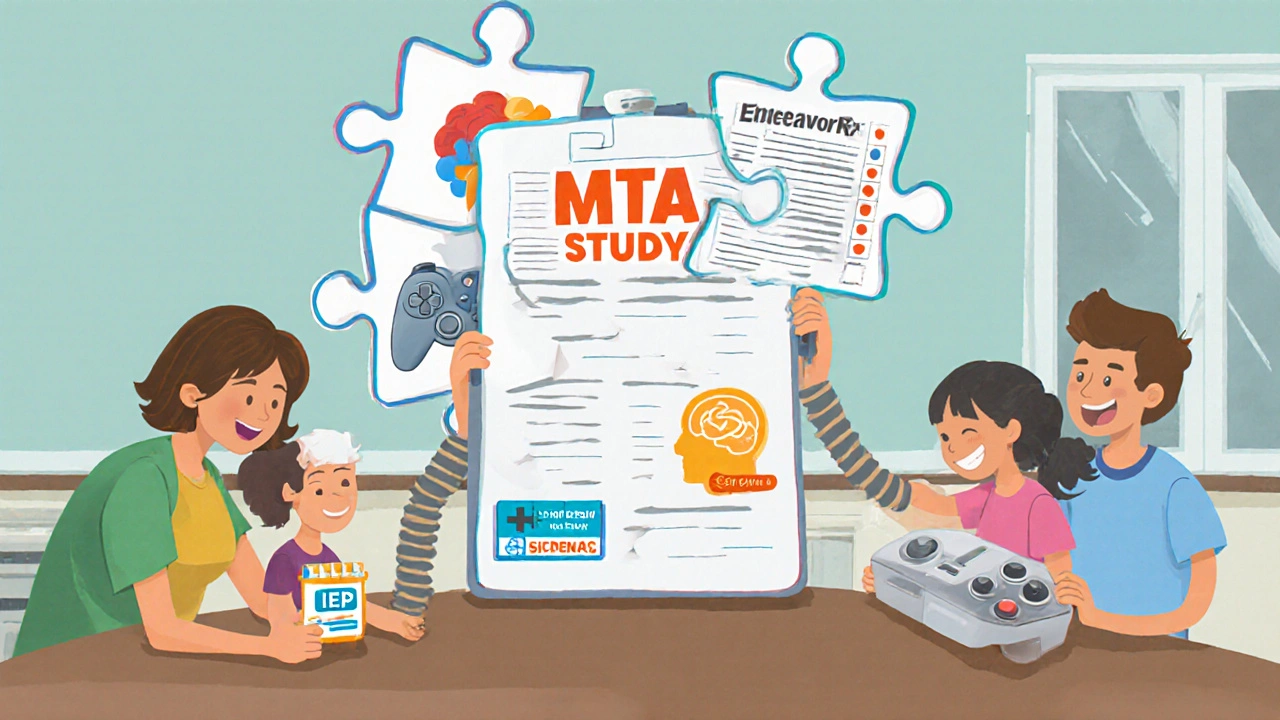
When you or your child is diagnosed with ADHD, the first question isn’t just what to do-it’s where to start. With so many options-medications, therapy, school accommodations-it’s easy to feel overwhelmed. The truth is, there’s no single fix. But there is a proven path: combining medication with real-world behavioral strategies. This isn’t theory. It’s what thousands of families and doctors have tested over decades, and what the science keeps confirming: the best outcomes come from using both tools together.
Stimulants: The Fast-Acting Foundation
Stimulants are still the most common and effective first-line treatment for ADHD. About 70 to 80% of people-kids and adults-see clear improvements in focus, impulse control, and task completion when they start taking them. These aren’t party drugs or mood boosters. They’re precisely calibrated medicines that help the brain’s prefrontal cortex work better. That’s the part responsible for planning, paying attention, and stopping yourself from blurting out or jumping up mid-class.
The two main classes are methylphenidate and amphetamine. Methylphenidate includes brands like Ritalin, Concerta, and Focalin. Amphetamines include Adderall, Vyvanse, and Dexedrine. They work differently but end up doing the same thing: boosting dopamine and norepinephrine in the brain. Methylphenidate blocks the reabsorption of these chemicals. Amphetamines push them out and block their reuptake. Both increase availability where it’s needed most.
Extended-release versions are now the standard. A pill like Concerta lasts 10 to 12 hours. Immediate-release Ritalin? Only 3 to 4. That’s why most doctors start with extended-release now-it means fewer doses, fewer disruptions, and smoother symptom control throughout the school day or workday.
But they’re not magic. Side effects are common. Appetite loss hits 50 to 60% of kids. Sleep problems? Around 30 to 50%. Headaches and stomachaches show up in 15 to 20%. Some people feel emotionally flat-less expressive, less reactive. On Reddit’s r/ADHD, 68% of over 1,800 respondents said appetite suppression didn’t go away. That’s not rare. It’s expected.
Doctors start low. For a child, that might mean 5 mg of methylphenidate or 2.5 mg of amphetamine once a day. They increase slowly, usually by 5 to 10 mg per week, watching for both improvement and side effects. The goal isn’t to eliminate all symptoms-it’s to find the lowest dose that makes daily life manageable.
Non-Stimulants: The Slower, Safer Alternative
Not everyone can take stimulants. Maybe they have a heart condition. Maybe they’ve struggled with substance use. Maybe the side effects are just too much. That’s where non-stimulants come in.
Atomoxetine (Strattera) is the most common. It doesn’t touch dopamine directly. Instead, it blocks the reuptake of norepinephrine. It’s not fast. It takes 4 to 6 weeks to build up in your system. But once it does, it works all day, every day-no peaks, no crashes. Response rates are lower than stimulants-about 50 to 60%-but for some, it’s the only thing that works without triggering anxiety or sleep issues.
Then there are the alpha-2 agonists: guanfacine (Intuniv) and clonidine (Kapvay). These were originally blood pressure meds. Turns out, they calm the overactive brain too. They work by targeting receptors in the prefrontal cortex, helping with emotional regulation and impulse control. They’re especially helpful for kids who are hyperactive, impulsive, or have trouble with emotional outbursts. They can also help with sleep, which stimulants often ruin.
Non-stimulants don’t carry the same abuse risk. No one’s snorting Intuniv. No one’s selling their Vyvanse. That’s a big deal for families worried about misuse. But they’re not a quick fix. If you need help getting through a test or a meeting tomorrow, non-stimulants won’t give it to you. They’re for the long haul.

Behavioral Strategies: Building Skills, Not Just Suppressing Symptoms
Medication helps you focus. But it doesn’t teach you how to organize your desk, remember homework, or calm down when you’re frustrated. That’s where behavioral strategies come in. They’re not optional extras. They’re essential.
For kids, parent training is the gold standard. Programs like the New Forest Parenting Programme require 12 to 16 weekly sessions, each about 90 minutes. Parents learn to give clear, simple instructions. They learn how to use immediate, consistent rewards for good behavior-not just punishment for bad. They learn to break tasks into tiny steps. A chore like “clean your room” becomes: “Pick up your toys. Put them in the bin. Now put your books on the shelf.” Each step gets a sticker. Five stickers = screen time.
For teens and adults, coaching works. A coach doesn’t tell you what to do. They help you figure out what gets in your way. Maybe you’re overwhelmed by clutter. Maybe you forget deadlines because your brain doesn’t register time the same way. A coach helps you build systems: phone alarms labeled “Start Essay,” color-coded calendars, a 5-minute nightly reset ritual.
Schools play a role too. An IEP or 504 Plan isn’t a handout. It’s a legal tool. It can mean extended time on tests, permission to move around during class, or a quiet space to take a break. Teachers who understand ADHD don’t see a “lazy kid.” They see someone whose brain works differently.
The biggest win? When medication gives you the mental space to actually learn these skills. You can’t build habits when you’re constantly distracted. But when your brain is calmer, you can practice organization, time management, and emotional control. That’s what sticks.
Putting It All Together: What Works Best
The landmark MTA study from 1999 followed over 500 kids with ADHD for years. It compared four groups: medication only, behavioral therapy only, both, and none. The group that got both medication and behavioral therapy did better than any other group-in academics, social skills, family relationships, and self-esteem. The difference wasn’t small. It was significant across the board.
That’s why the American Academy of Pediatrics recommends this combo as the standard. Medication handles the brain chemistry. Behavioral strategies handle the life skills. Together, they cover what neither can do alone.
For example: a child on Concerta might still forget to turn in homework. But with a daily checklist, a reward system for turning in assignments, and a weekly parent-teacher check-in, that behavior changes. A teen on Vyvanse might still struggle with emotional outbursts. But with a therapist teaching mindfulness and emotional labeling, those reactions become less intense.
Even adults benefit. Someone on Strattera might still miss meetings. But with a digital calendar synced to phone alerts and a weekly planning ritual, they start showing up on time. The medication helps them stay focused. The system helps them follow through.

Monitoring and Adjusting: What Doctors Watch For
Starting medication isn’t a one-time decision. It’s a process.
Before any stimulant is prescribed, doctors check blood pressure and heart rate. They ask about family history of heart problems. They screen for tics, anxiety, or eating disorders-especially since stimulants can worsen these in some people. The FDA now recommends screening for eating disorders before starting stimulants, given new data showing a 12% increased risk in vulnerable individuals.
Once on medication, kids need height and weight checked every six months. Growth suppression is real. About 30% of kids slow down in the first year. But for most, it evens out by year three. Still, it’s tracked.
For adults, regular check-ins matter too. If your heart races after your morning dose, your doctor needs to know. If you’re sleeping worse, they can adjust timing. Many people take their last dose 6 to 8 hours before bedtime. That cuts sleep problems by 65%.
Cost is another factor. Generic methylphenidate can cost $15 to $25 a month. Brand-name extended-release? $250 to $400 without insurance. Many insurers require you to try the generic first. That’s called step therapy. It’s frustrating-but it’s common.
What’s New in ADHD Treatment
The field isn’t standing still. In 2023, the FDA approved AZSTARYS-a new combo pill that combines serdexmethylphenidate and dexmethylphenidate. It’s designed to reduce abuse potential while lasting 13 hours. That’s promising for teens and adults who’ve struggled with misuse.
Non-drug options are growing too. EndeavorRx, an FDA-cleared video game for kids aged 8 to 12, has been shown to improve attention after 25 minutes of play, five days a week for four weeks. VR-based cognitive training is now in phase 3 trials. These aren’t gimmicks. They’re digital therapies, backed by data.
And then there’s pharmacogenetics. Tests like Genomind’s PGx Express look at your genes-specifically CYP2D6 and CYP2C19-to predict how your body will process certain stimulants. If you’re a slow metabolizer, you might need a lower dose. If you’re a fast one, you might need more. This isn’t routine yet, but it’s coming fast. In 2023, the test correctly predicted 65% of non-responders to specific meds.
For now, the best advice remains simple: start with the proven. Use medication to quiet the noise in your brain. Use behavioral tools to build the skills you need to live well. And don’t give up if the first thing doesn’t click. ADHD treatment is a puzzle. You’re not failing-you’re just still finding the right pieces.
Do stimulants make ADHD worse over time?
No. Long-term studies, including the 20-year follow-up of the MTA trial, show that stimulant use doesn’t harm adult outcomes. Some people stop taking them in adolescence because side effects fade or they feel they don’t need them anymore-but that’s not because the meds caused damage. It’s because their needs changed.
Can adults take ADHD medication too?
Absolutely. About 4% of U.S. adults have ADHD, and many were never diagnosed as kids. Stimulants and non-stimulants work just as well for adults. The biggest difference? Adults often need help with time management, organization, and emotional regulation-skills that behavioral coaching can build. Medication helps them focus; therapy helps them use that focus wisely.
Why do girls with ADHD often go undiagnosed?
Girls with ADHD often present differently. Instead of being hyperactive, they’re daydreamy, disorganized, or quietly anxious. Their symptoms don’t disrupt class the same way. Teachers and parents miss it. By the time they’re diagnosed, often in high school or college, they’ve spent years feeling like they’re failing. That’s why girls are more likely to be prescribed non-stimulants-they’re often more sensitive to side effects, and stimulants can worsen anxiety.
What if medication doesn’t work at all?
It happens. About 20 to 30% of people don’t respond well to the first stimulant tried. That doesn’t mean nothing will work. Switching to a different stimulant-say, from methylphenidate to amphetamine-often helps. If that fails, non-stimulants are the next step. And if meds still don’t help, behavioral strategies alone can still make a big difference. Many adults manage ADHD successfully without medication, using coaching, routines, and environmental adjustments.
Are there natural alternatives to medication?
Exercise, sleep, and diet help-but they don’t replace medication for moderate to severe ADHD. Regular physical activity boosts dopamine naturally. Good sleep improves focus. Omega-3s might help a little. But none of these match the effect size of stimulants. They’re best used as supports, not substitutes. If you’re trying to avoid meds, start with behavioral strategies first. They’re evidence-based and have zero side effects.
How long should someone stay on ADHD medication?
There’s no set timeline. Some people take it for life. Others stop after high school or college. It depends on how much the symptoms interfere with daily life. If you’re managing well at work, in relationships, and with your own mental health, you might not need it anymore. If you’re constantly missing deadlines, forgetting appointments, or feeling overwhelmed, it’s worth continuing. Regular check-ins with your doctor help you decide when to try tapering off.
Comments (8)
-
Edward Weaver November 8, 2025
Let me break this down for you like you're five: stimulants aren't 'magic pills'-they're neurochemical scalpels. If your kid's on Adderall and still can't tie their shoes, you're not doing the behavioral stuff right. Stop blaming the med and start coaching. I've seen parents hand their 10-year-old a 10mg pill and then wonder why they're still melting down at bedtime. That's not ADHD-it's lazy parenting. The science? Solid. The execution? Usually garbage.
-
Jim Oliver November 8, 2025
70-80% response rate? Sure. But 68% of Reddit users say appetite loss never fades? That’s not a side effect-that’s a dealbreaker. And you call Strattera ‘safer’? It’s slower than molasses in January and raises liver enzymes. Also, ‘behavioral strategies’? Sounds like a fancy way to say ‘parenting 101.’ My kid’s not a lab rat. Stop pretending this is science. It’s a pharmaceutical industry feeding frenzy.
-
William Priest November 9, 2025
okay so like… stimulants are basically like coffee but stronger? and the non-stimulants are like… tea? but slower? idk why everyone makes this sound so complicated. also i read somewhere that vr games for adhd are basically just fancy pac-man? and the gene test? bro that’s like asking your horoscope if you should take vyvanse. also why are we still talking about concerta like it’s the holy grail? i got generic methylphenidate for $12 and it works fine. stop overthinking it.
-
Ryan Masuga November 10, 2025
I just want to say-this is actually one of the clearest, most compassionate overviews I’ve read. I’ve been on Strattera for 3 years and honestly? It’s been life-changing, even if it took 6 weeks to kick in. And the behavioral stuff? I started using color-coded calendars and now I don’t miss a single meeting. It’s not magic, but it’s real. To anyone feeling overwhelmed: you’re not broken. You’re just wired differently. And that’s okay. Progress, not perfection. You’ve got this.
-
Jennifer Bedrosian November 10, 2025
OMG I just cried reading this because my daughter was diagnosed last year and I thought I was failing as a mom… I’ve been so scared to give her meds because I thought it would change her personality but now I get it-it’s not about making her quiet, it’s about helping her be herself without drowning in chaos. And the sticker chart? We’re doing that now and she actually smiles when she gets 5 stickers. Thank you for writing this. I’m not alone.
-
Lashonda Rene November 11, 2025
So I’ve been reading all this and I just want to say that I think people forget that ADHD isn’t just about being distracted or hyperactive-it’s like your brain is running 17 tabs at once and none of them are closed and you’re trying to type a letter but your cat just knocked over your coffee and your phone is ringing and your boss just texted and you forgot your keys and your kid needs help with math and you haven’t slept since Tuesday and you’re trying to be a good person but your brain just keeps yelling at you to stop trying because it’s too hard. And meds help quiet the yelling. And the routines? They’re like building a fence around the chaos so you can breathe. I don’t know if this makes sense but it’s how I feel.
-
Andy Slack November 13, 2025
Biggest takeaway: medication gives you the space. Behavioral tools give you the structure. You need both. One without the other is like having a Ferrari with no steering wheel. I started coaching after years of failing at jobs. Now I use voice memos to plan my day. I set alarms labeled ‘STOP scrolling.’ I take a 5-minute walk before every meeting. It’s not glamorous. But it works. And yeah-I’m on Vyvanse. But the real win? I finally feel like I’m in control. Not the ADHD.
-
Rashmi Mohapatra November 14, 2025
USA always think their way is best. In India we don't use pills for ADHD. We use yoga, meditation, and strict routine. Also kids play outside 5 hours a day. No screens. No meds. No problem. Why you need drug? Your life too easy. Maybe you need to stop being so soft. My cousin's son-no medicine, no therapy-now he is IIT engineer. Simple life, strong mind.
